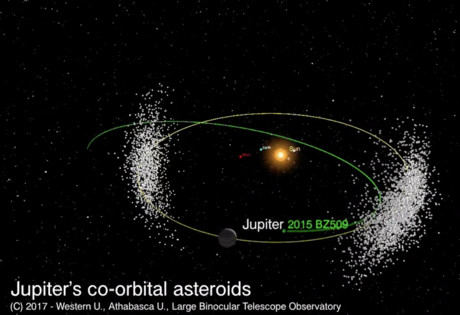Wrong way, turn back: oddball asteroid 'playing chicken' with Jupiter

If you’ve ever found yourself walking against the flow of pedestrian traffic, you’ll know how difficult it can be to navigate through the onslaught of people and to come out the other side unscathed. Now imagine that instead of being humans, you and everyone else is an asteroid — and you’re heading straight towards Jupiter.
More than 99% of the million or so known asteroids in our solar system travel around the Sun in what’s called a prograde motion — that is, counter-clockwise when visualised from above — with only 82 known outliers. Asteroid 2015 BZ509 (‘Bee-Zed’ for short) is a very special case, however — it’s the only asteroid in this solar system known to have a clockwise, retrograde orbit around the Sun while at the same time sharing a planet’s orbital space.
“If you imagine the solar system as a race track, where the planets are these monster trucks and the asteroids are these ridiculously small clown cars going around the Sun, they’re all going in one direction — except for a few oddballs, like Bee-Zed,” said Paul Wiegert of Western University, Canada. Bee-Zed is instead driving around the track in the wrong direction, steering between the 6000 other cars and swerving around the monster truck, in a series of manoeuvres it has been making for at least one million years.
Wiegert and his team have been studying Bee-Zed using telescope observations and computer simulations since not long after it was discovered in January 2015, seeking to understand how it manages to avoid colliding with Jupiter. Their study, published in the journal Nature, found that Jupiter’s gravity actually deflects the asteroid’s path at each pass so as to allow both to continue safely on their way.
“Bee-Zed manages to avoid Jupiter by swerving around it at just the right moment, and Jupiter’s gravity actually helps it do that — it traps it in this kind of state and protects it,” said Wiegert.
So what else has the team managed to learn about Bee-Zed? Well, apparently it has a diameter of about 3 km and it may have originated from the same place as Halley’s Comet, which also has a retrograde orbit. The team’s calculations have also found that the asteroid has managed to maintain a stable orbit for at least a million years and will be stable for at least a million more, providing something of a mystery as to how it came to act like this in the first place.
“Bee-Zed might be an ordinary asteroid that just got into this strange state through an extraordinary set of coincidences, or it might be something fundamentally different and maybe even a little bit more interesting,” said Wiegert.
“The detective work has just begun.”
Govt announces $158m in funding for three new CRCs
Minister for Industry and Science Ed Husic has allocated $158 million to three new Cooperative...
Why are young plants more vulnerable to disease?
Fighting disease at a young age often comes at a steep cost to plants' growth and future...
Liquid catalyst could transform chemical manufacturing
A major breakthrough in liquid catalysis is transforming how essential products are made, making...





